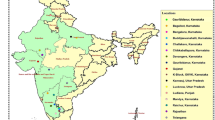Abstract
A collection of Plasmopara halstedii s. l. from Helianthus × laetiflorus is recorded, described and characterised by laboratory cross infection studies, light microscopical studies, fatty acid pattern and LSU rDNA data. Its ability to infect Helianthus annuus was demonstrated in laboratory cross infection studies, however, it could not be unequivocally ascribed to a known pathotype. Microscopically, it shows no differences from isolates originating from Helianthus annuus, its fatty acid pattern is indistinguishable, and also its LSU rDNA sequence is identical. Due to this identity in a broad range of characters, the investigated downy mildew isolates from H. × laetiflorus and from H. annuus are regarded as conspecific.
Similar content being viewed by others
References
Anonymous (1966) Index of fungi 3(12), p. 364. Commonwealth Mycological Institute, Kew.
Delanoe D (1972) Biologie et epidemiologie du mildiou du tournesol. CETIOM Informations Techniques 26: 1–61.
Berlese AN, De Toni JB (1888) Phycomyceteae. In Saccardo PA (ed.) Sylloge Fungorum Omnium Hucusque Cognitorum, vol 7, pp. 181–322.
Felsenstein J (1985) Confidence limits on phylogenies: an approach using the bootstrap. — Evolution 39: 783–791.
Gu X, Fu YX, Li WH (1995) Maximum likelihood estimation of the heterogeneity of substitution rate among nucleotide sites. — Molecular Biology and Evolution 12: 546–557.
Gulya TJ, Rashid KY, Masirevic SM (1997) Sunflower diseases. In Schneiter AA (ed.) Sunflower technology and production, pp. 263–379. No 35 Agronomy. American Society of Agronomy, Madison, Wisconsin, USA.
Gulya TJ, Tourvieille de Labrouhe D, Masirevic SM, Penaud A, Rashid KY, Viranyi F (1998) Proposal for standardized nomenclature and identification of races of Plasmopara halstedii (sunflower downy mildew). In Proceedings of the ISA Symposium. III. Sunflower Downy Mildew. Fargo, ND, 13–14 Jan. 1998, pp. 130–136.
Hall TA (1999) BioEdit: a user-friendly biological sequence alignment editor and analysis program for Windows 95/98/NT. — Nucleic Acids Symposium Series 41: 95–98.
Hasegawa M, Kishino H, Yano T (1985) Dating of the human-ape splitting by a molecular clock of mitchondrial DNA. — Journal of Molecular Evolution 22: 160–174.
Leppik EE (1966) Origin and specialization of Plasmopara halstedii complex on the Compositae. — FAO Plant Production Bulletin 14: 72–76.
Moncalvo JM, Wang HH, Hseu RS (1995) Phylogenetic relationships in Ganoderma inferrred from the internal transcribed spacers and 25S ribosomal DNA sequences. — Mycologia 87: 223–238.
Nishimura M (1922) Studies in Plasmopara halstedii. — Journal of the College of Agriculture, Hokkaido Imperial University 11: 185–210.
Novotelnova NS (1962a) K woprosu o ložnoj mučnistoj rose podsolnečnika. — Sbornik Dokladov Naučnoj Konferencii po Zaščita Rastenij (Tallin): 129–139.
Novotelnova NS (1962b) Plasmopara halstedii (Farl.) Berl. et De Toni as a conspecies (substantiation of the taxonomic classification of the species of Plasmopara infesting Compositae). — Botaničeskij Žurnal 47: 970–981 (in Russian).
Novotelnova NS (1963) Nowye widy Plasmopara na Compositae. — Botaničeskie materialy Otdela sporvykh rastenii Botanicheskogo instituta Akademii nauk SSSR 16: 72–83.
O’Donnell K (1993). Fusarium and its near relatives. In Reynolds DR, Taylor JW (eds) The fungal holomorph: mitotic, meiotic and pleomorphic speciation in fungal systematics, pp. 225–233. CAB International, Wallingford, UK.
Posada D, Crandall KA (1998) MODELTEST: testing the model of DNA substitution. — Bioinformatics 14: 817–818.
Riethmüller A, Voglmayr H, Göker M, Weiß M, Oberwinkler F (2002) Phylogenetic relationships of the downy mildews (Peronosporales) and related groups based on nuclear large subunit ribosomal DNA sequences. — Mycologia 94: 834–849.
Rozynek B, Spring O (2000) Pathotypes of sunflower downy mildew in southern parts of Germany. — Helia 23: 27–34.
Sackston WE (1981) Downy mildew of sunflower. In Spencer DM (ed.) The Downy Mildews, pp. 545–575. Academic Press, London.
Saitou N, Nei M (1987) The neighbor-joining method: a new method for reconstructing phylogenetic trees. — Molecular Biology and Evolution 4: 406–425.
Spring O, Haas K (2002a) The fatty acid composition of Plasmopara halstedii and its taxonomic significance. — European Journal of Plant Pathology 108: 263–267.
Spring O, Haas K (2002b) The taxonomic significance of fatty acid patterns in biotrophic Oomycetes. — Proceedings Botanikertagung 2002, Freiburg, Germany, Deutsche Botanische Gesellschaft, p. 436.
Spring O, Rozynek B, Zipper R (1997) Leaf disk inoculation-a useful tool for selecting infections of sunflower downy mildew at low inoculum concentration, but inappropriate to pathotypes characterization. — Journal of Phytopathology 145: 189–191.
Spring O, Schilling EE (1990) The origin of Helianthus × multiflorus and H. × laetiflorus (Asteraceae). — Biochemical Systematics and Ecology 18: 19–23.
Swofford DL (2002) PAUP*. Phylogenetic analysis using parsimony (*and other methods), ver. 4b10. Sinauer, Sunderland, Mass.
Thompson JD, Gibson TJ, Plewniak F, Jeanmougin F, Higgins DG (1997) The ClustalX windows interface: flexible strategies for multiple sequence alignment aided by quality analysis tools. — Nucleic Acids Research 24: 4876–4882.
Vilgalys R, Hester M (1990) Rapid genetic identification and mapping of enzymatically amplified ribosomal DNA from several Cryptococcus species. — Journal of Bacteriology 172: 4238–4246.
Virányi F (1984) Recent research on the downy mildew of sunflower in Hungary. — Helia 7: 35–38.
Walcz I, Bogar K, Viranyi F (2000) Study on an Ambrosia isolate of Plasmopara halstedii. — Helia 23: 19–24.
Author information
Authors and Affiliations
Corresponding author
Rights and permissions
About this article
Cite this article
Spring, O., Voglmayr, H., Riethmüller, A. et al. Characterization of a Plasmopara isolate from Helianthus × laetiflorus based on cross infection, morphological, fatty acids and molecular phylogenetic data. Mycol Progress 2, 163–170 (2003). https://doi.org/10.1007/s11557-006-0054-3
Accepted:
Issue Date:
DOI: https://doi.org/10.1007/s11557-006-0054-3




